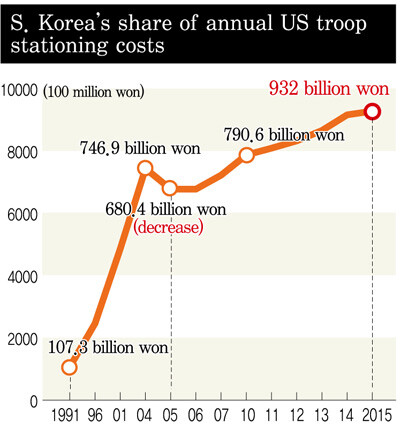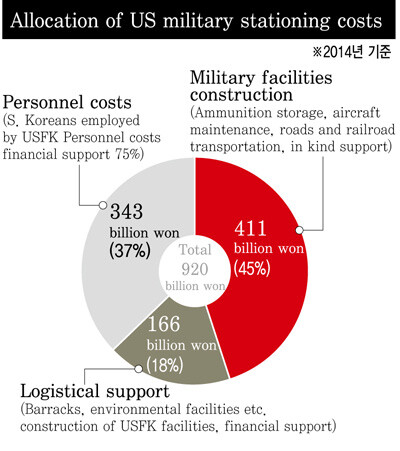hankyoreh
Links to other country sites 다른 나라 사이트 링크
Sorry, Trump: South Korea actually covers more like 70% of US troop stationing costs

With Donald Trump - now confirmed as the US Republican Party’s candidate for president - arguing that other countries should pay the entire cost of stationing US troops on their soil, attention is turning to the percentage and the total amount of South Korea’s contribution to the cost of hosting US troops on the Korean Peninsula.
Trump’s argument is that, since US troops in South Korea are stationed there for its defense, the beneficiary of that defense (that is, South Korea) ought to pay the entire cost. But many critics point out that Trump‘s remarks ignore the fact that there are various reasons for maintaining a US military presence on the Korean Peninsula and that, of these, defending South Korea is less important than protecting US economic, political and military interests in Northeast Asia.
Since the US officially adopted the policy of rebalancing to Asia in order to check China in 2011, the US has deployed troops on rotation into countries such as Australia and the Philippines. In addition, it is long since US Forces Korea stopped functioning as a permanent defensive fixture only on the Korean Peninsula, as shown by the agreement about “strategic flexibility” that Washington and Seoul reached in Jan. 2006.
The question is whether Trump’s complaints about US allies getting a free ride can be regarded as merely being off-the-cuff remarks.
“Combined with the pressure the US is under to cut its defense spending because of its huge budget deficit, this could lead to more calls in the US for bigger contributions from its allies,” said a South Korean military officer on May 6. “I think that we need to start getting ready for this by crafting an argument to persuasively express our position.”
Last year, the sum paid by South Korea as its share of US defense costs was 932 billion won (US$799.01 million). That sum was based on the latest iteration of the US and South Korea’s defense sharing arrangement, which was renegotiated in Feb. 2014. According to this agreement, South Korea’s share of the cost was 920 billion won for 2014, with this amount increasing proportionally to the cost of consumer goods for five years (2014 to 2018).

When the defense sharing arrangement was first made in 1991, South Korea paid 107.3 billion won - since then, this amount has increased nine fold.
The US regards South Korea’s defense share as representing half of the cost of stationing US forces here. During his confirmation hearing before the US Senate on Apr. 19, USFK Commander Vincent K. Brooks said that South Korea had covered 50% of the cost of stationing US troops in South Korea the previous year through the Special Measures Agreement (SMA).
But the actual cost covered by South Korea is much greater than this, when a number of benefits provided by the South Korean government are taken into account, including land grants and reductions or exemptions on various taxes and utilities.
According to the office of the US Assistant Secretary of Defense’s 2012 overview of its operations and maintenance budget, which was acquired and published in 2013 by a South Korean civic group called Solidarity for Peace and Reunification of Korea, the total amount of money spent by the US Defense Department in 2010 on stationing US troops in South Korea (excluding wages for US soldiers and civilian employees) was US$773.30 million (893.9 billion won).
But according to reports that South Korea’s Defense Ministry provided the National Assembly, during the same year the South Korean government provided US Forces Korea with a total of 1.67 trillion won. This included not only the 790.4 billion won in defense sharing but also 65.7 billion won in direct support (Korean Augmentation to the United States Army [KATUSA], police, real estate and maintenance around the base) and 818.8 billion won in indirect support (estimated rental value of land provided for free, reductions and exemptions on taxes and utilities, exemptions on the cost of using roads, ports and airports and railroad transportation). This means that South Korea is effectively paying for 65.1% of the cost of keeping US troops in South Korea, while the US is paying for 34.9%.
“Even with these figures, the appraised value of the land provided to the US military has been undervalued by somewhere between 2.5% and 5%. Considering this, South Korea is actually covering more than 70% of the cost of stationing US forces in South Korea,” said Yu Yeong-jae, who leads a team at Solidarity for Peace and Reunification of Korea working on the US military issue
By Park Byong-su, senior staff writer
Please direct questions or comments to [english@hani.co.kr]

Editorial・opinion
![[Column] Park Geun-hye déjà vu in Yoon Suk-yeol [Column] Park Geun-hye déjà vu in Yoon Suk-yeol](https://flexible.img.hani.co.kr/flexible/normal/500/300/imgdb/original/2024/0424/651713945113788.jpg) [Column] Park Geun-hye déjà vu in Yoon Suk-yeol
[Column] Park Geun-hye déjà vu in Yoon Suk-yeol![[Editorial] New weight of N. Korea’s nuclear threats makes dialogue all the more urgent [Editorial] New weight of N. Korea’s nuclear threats makes dialogue all the more urgent](https://flexible.img.hani.co.kr/flexible/normal/500/300/imgdb/original/2024/0424/7317139454662664.jpg) [Editorial] New weight of N. Korea’s nuclear threats makes dialogue all the more urgent
[Editorial] New weight of N. Korea’s nuclear threats makes dialogue all the more urgent- [Guest essay] The real reason Korea’s new right wants to dub Rhee a founding father
- [Column] ‘Choson’: Is it time we start referring to N. Korea in its own terms?
- [Editorial] Japan’s rewriting of history with Korea has gone too far
- [Column] The president’s questionable capacity for dialogue
- [Column] Are chaebol firms just pizza pies for families to divvy up as they please?
- [Column] Has Korea, too, crossed the Rubicon on China?
- [Correspondent’s column] In Japan’s alliance with US, echoes of its past alliances with UK
- [Editorial] Does Yoon think the Korean public is wrong?
Most viewed articles
- 1‘We must say no’: Seoul defense chief on Korean, USFK involvement in hypothetical Taiwan crisis
- 2N. Korean delegation’s trip to Iran shows how Pyongyang is leveraging ties with Moscow
- 3‘Weddingflation’ breaks the bank for Korean couples-to-be
- 4[Column] Park Geun-hye déjà vu in Yoon Suk-yeol
- 5Korea sees more deaths than births for 52nd consecutive month in February
- 6[Guest essay] The real reason Korea’s new right wants to dub Rhee a founding father
- 7[Column] The clock is ticking for Korea’s first lady
- 8[Column] Has Korea, too, crossed the Rubicon on China?
- 9Why Korea shouldn’t welcome Japan’s newly beefed up defense cooperation with US
- 10Will NewJeans end up collateral damage in internal feud at K-pop juggernaut Hybe?